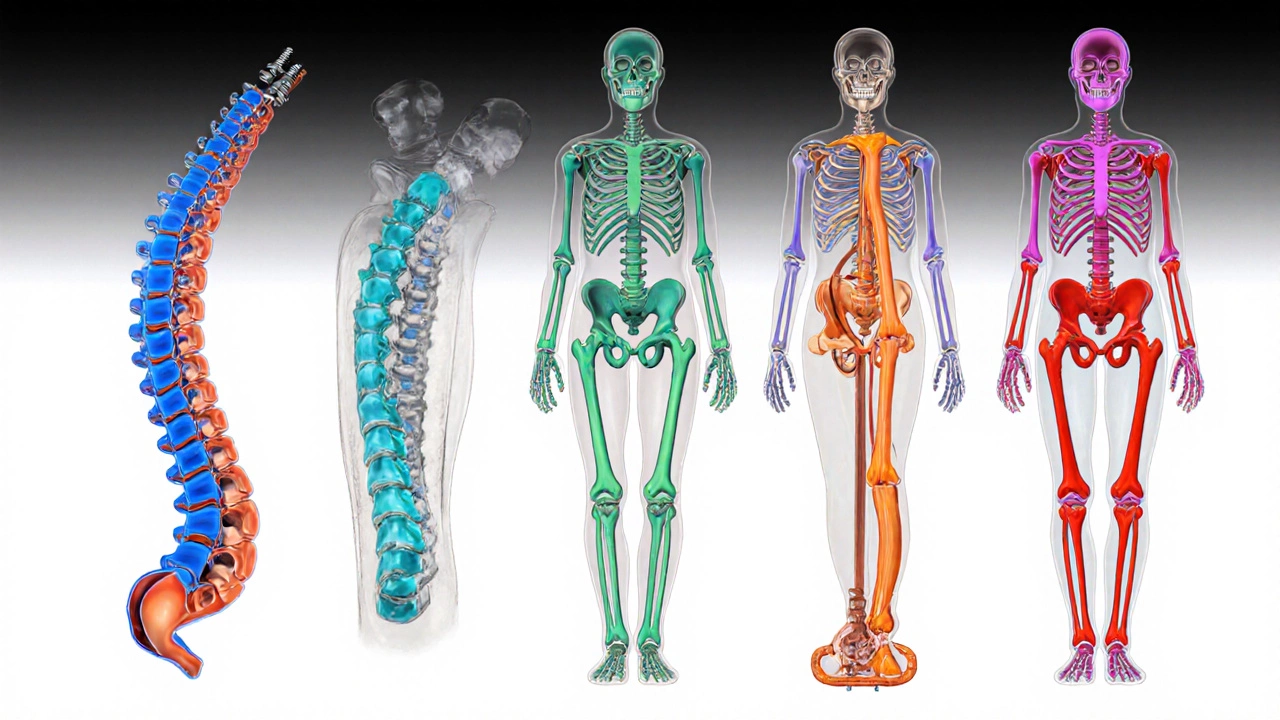Recovery Challenge Calculator
How difficult will your recovery be?
Enter your specific surgical procedure and personal factors to get a personalized recovery challenge assessment.
Recovery Assessment
Estimated Recovery Time: 0 months
Key Recommendations: Loading...
Quick Takeaways
- Spinal fusion, total hip replacement, and complex limb‑lengthening procedures rank highest for recovery difficulty.
- Average full‑recovery timelines range from 6months (hip) to 12-18months (spinal fusion, limb lengthening).
- Age, pre‑existing conditions, and strict rehab compliance dramatically affect outcomes.
- Early mobilization, proper nutrition, and pain‑management strategies can shave weeks off healing.
- Watch for red‑flag symptoms like fever, intense swelling, or sudden loss of function - they often signal complications.
Why the Question Matters
When you face an orthopedic operation, the first thought after the surgeon’s consent form is usually, “How long will it take to get back to normal?” Knowing which procedures demand the toughest post‑op journey helps you set realistic expectations, arrange support at home, and choose a surgeon who specializes in the toughest recoveries.
Surgeries With the Hardest Recovery
Below are the six orthopedic interventions that consistently show the longest and most demanding rehab periods, based on data from the American Academy of Orthopaedic Surgeons (AAOS) and recent peer‑reviewed studies.
Spinal Fusion - a procedure that joins two or more vertebrae with bone graft, rods, and screws.
Recovery time: 9-12months for full functional return; 6months for basic daily activities.
Why it’s tough: The spine loses natural motion at the fused segment, forcing adjacent levels to compensate. Muscles around the spine must be retrained, and any misalignment can cause chronic pain. Post‑op protocols often restrict bending and lifting for several months, and patients must wear a brace for up to 12 weeks.
Total Hip Replacement - a surgery that replaces the femoral head and acetabulum with prosthetic components.
Recovery time: 4-6months for most daily tasks; up to 12months for high‑impact sports.
Why it’s tough: While pain relief is dramatic, the surrounding muscles (gluteals, abductors) become weakened after surgery. Patients must perform daily gait‑training and strengthen the hip to avoid limp and dislocation risk. Age‑related bone quality can also slow implant integration.
Total Knee Replacement - replacement of the femoral, tibial, and sometimes patellar surfaces.
Recovery time: 6-9months for full range of motion; up to 12months for heavy activities.
Why it’s tough: The knee’s complexity demands precise alignment; any slight misplacement can cause stiffness or early wear. Swelling often peaks at 2weeks and can linger, making strength training sluggish. Patellar tracking issues may require additional interventions.
Ankle Fusion - surgical joining of the tibia, talus, and sometimes calcaneus.
Recovery time: 6-12months before the foot can bear weight without assistive devices.
Why it’s tough: The ankle loses its primary motion, forcing the subtalar and midfoot joints to take over. This can create painful overloads. Patients often need custom orthotics and a prolonged period of protected weight‑bearing.
Limb Lengthening (Ilizarov or Hexapod) - gradual distraction osteogenesis to increase bone length.
Recovery time: 12-18months overall, including consolidation phase.
Why it’s tough: The process involves a slow, controlled fracture that must heal while the bone is being mechanically stretched. Pin‑site infections, nerve irritation, and muscle contractures are common. Daily physiotherapy is mandatory to prevent joint stiffness.
Complex Pelvic or Acetabular Fracture Fixation - open reduction and internal fixation (ORIF) of high‑energy pelvic breaks.
Recovery time: 9-15months for full ambulation without limp.
Why it’s tough: The pelvis houses major vessels, nerves, and organs. Surgery is often extensive, requiring multiple incisions and hardware. Early mobilization is limited to protect the repair, and weight‑bearing may be delayed for up to 12 weeks.
Comparison of Average Recovery Timelines
| Procedure | Full Recovery (Months) | Key Limiting Factor |
|---|---|---|
| Spinal Fusion | 9‑12 | Loss of segmental motion & muscle re‑education |
| Total Hip Replacement | 4‑12 | Muscle weakness & dislocation precautions |
| Total Knee Replacement | 6‑12 | Swelling & joint stiffness |
| Ankle Fusion | 6‑12 | Compensatory overload of neighboring joints |
| Limb Lengthening | 12‑18 | Gradual bone distraction & soft‑tissue adaptation |
| Pelvic Fracture Fixation | 9‑15 | Complex anatomy and delayed weight‑bearing |

Factors That Influence Recovery Speed
- Age and Bone Quality: Older patients often have osteoporotic bone, slowing graft incorporation and implant fixation.
- Pre‑Existing Health Conditions: Diabetes, smoking, and cardiovascular disease impair wound healing.
- Compliance with Physical Therapy: Skipping scheduled PT sessions adds weeks or months to the timeline.
- Nutrition: Adequate protein (1.2‑1.5g/kg body weight) and vitamin D support bone remodeling.
- Psychological Outlook: Positive mindset correlates with quicker functional gains; depression can delay progress.
Practical Tips to Smooth the Toughest Recoveries
- Start Gentle Motion ASAP: Even passive range‑of‑motion (ROM) within surgeon‑approved limits reduces scar tissue.
- Use a Structured PT Plan: Follow a weekly schedule that balances strength, balance, and cardio.
- Weeks1‑3: Isometric activations and ankle pumps.
- Weeks4‑8: Closed‑chain exercises (e.g., mini‑squats, step‑ups).
- Weeks9‑16: Progressive loading and gait training.
- Watch Your Nutrition: Aim for 30-35% of calories from high‑quality protein, add omega‑3 rich foods to curb inflammation.
- Manage Pain Wisely: Combine scheduled NSAIDs with short‑acting opioids only when needed. Over‑reliance on pain meds can mask warning signs.
- Sleep and Elevation: Elevating the operated limb 2‑3hours daily reduces edema; 7-9hours of uninterrupted sleep boosts tissue repair.
- Stay Engaged Mentally: Use activities like audiobooks or light meditation during PT to reduce boredom and improve adherence.
When Recovery Doesn’t Go as Planned
Red‑flag symptoms deserve immediate medical attention:
- Fever >101°F (38.3°C) persisting beyond 48hours.
- Sudden increase in pain or swelling after a period of improvement.
- Clear fluid drainage from the incision (possible joint leak).
- Loss of sensation, tingling, or weakness in the limb.
- Inability to bear weight when cleared to do so.
Early detection of infection, hardware loosening, or non‑union can prevent permanent loss of function.

Choosing the Right Surgeon & Facility
For high‑complexity cases, look for surgeons who meet at least two of the following criteria:
- Board‑certified orthopaedic surgeon with a fellowship in spine, joint replacement, or trauma.
- Minimum of 100 annual procedures of the specific surgery you need.
- Published outcomes in peer‑reviewed journals showing <5% complication rates.
- Facility accreditation by The Joint Commission and a dedicated rehab unit.
Ask about their post‑op protocol, expected length of stay, and whether they have a multidisciplinary team (physiotherapist, pain specialist, nutritionist).
Bottom Line
The hardest orthopaedic surgeries to bounce back from are those that either lock major joints, require prolonged bone healing, or involve extensive soft‑tissue disruption. Understanding the timeline, investing in proper rehab, and staying alert to complications can turn a daunting recovery into a manageable process.
Frequently Asked Questions
How long does it take to fully recover from a spinal fusion?
Most patients regain basic daily function by 6months, but true full‑strength recovery-returning to sports or heavy lifting-usually needs 9‑12months. Regular physical therapy and avoiding early twisting motions are key.
Is there a way to shorten the rehab period after a total knee replacement?
Early mobilization within the first 24hours, combined with a balanced pain‑control regimen and a structured PT program focused on quad activation, can shave 4‑6weeks off the typical 6‑month timeline.
What are the most common complications after limb‑lengthening surgery?
Pin‑site infection, joint contracture, and delayed bone consolidation are the top three. Meticulous pin care, daily stretching, and regular X‑ray monitoring help prevent them.
Can I bear weight on an ankle fusion right after surgery?
Weight‑bearing is usually limited to 25% of body weight for 6weeks, often using a boot or crutches. Full weight‑bearing typically starts around week10, depending on X‑ray evidence of bone healing.
What diet supports faster bone healing after orthopedic surgery?
A diet rich in lean protein (30g per meal), calcium (1,000mg/day), vitamin D (800‑1,000IU/day), and magnesium (300‑400mg/day) promotes collagen synthesis and mineralization. Including leafy greens, dairy or fortified alternatives, and fatty fish adds necessary micronutrients.
